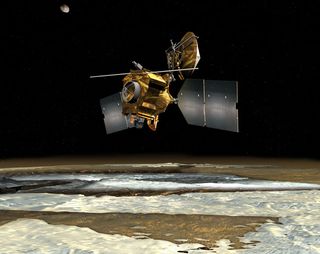Glitch Forces Mars Orbiter to Reboot Main Computer

NASA?s MarsReconnaissance Orbiter has unexpectedly rebooted its main computer and entereda protective safe mode after being hit by stray cosmic ray or solar particle aswhile circling the red planet.
The event occurredWednesday night at 9:10 p.m. EDT (0110 June 4 GMT) and appears similar to aglitch that stalled the powerful Marsorbiter?s science work in February, mission managers said.
?The flightteam is cautiously bringing the orbiter back to normal operations,? orbiterproject manager Jim Erickson at NASA?s Jet Propulsion Laboratory in Pasadena,Calif., said in a statement released Thursday. ?We should be resuming our exploration of Mars bynext week."
Ericksonsaid flight controllers are in contact with the beleaguered Mars ReconnaissanceOrbiter, which is beaming home data and is otherwise in good shape.
The orbiterhas entered the so-called safe mode six times since it launched toward Mars in2005. The mode is a safety precaution that allows the spacecraft to hunker downand await instructions from Earth when it detects a condition that it does nothave a specific response for, mission managers said.
The MarsReconnaissance Orbiter last entered safe mode on Feb. 23, when it detected apower spike that ultimately turned out to be a false reading. Engineers later determinedthat the erroneoussignal was most likely caused by a cosmic ray or solar particle hitting theorbiter?s sensitive electronics.
A similar eventis suspected in this week?s malfunction, mission managers said.
Get the Space.com Newsletter
Breaking space news, the latest updates on rocket launches, skywatching events and more!
The $720million Mars Reconnaissance Orbiter arrived at the red planet in October 2006and successfully completed its initial two-year mission in 2008. The probe?s Marssurvey has since been extended through at least 2010.
The MarsReconnaissance Orbiter is not the only ailing spacecraft currently at the redplanet. Down on the planet?s surface, NASA?s Marsrover Spirit is stuck up to its hubcaps after snaring its six wheels indeep Martian sand.
The rover recentlyused a camera on its robotic arm to take a snapshotof its belly so engineers can get a better look at its sandy quagmire. Engineersare hopeful they can free the long-lived Spirit rover so that it can continueits exploration of a region on Mars that scientists have dubbed ?Home Plate.?
Spirit andits robotic twin Opportunity, which is working fine and recently passed the10-mile mark in its own Martiantravels, have been exploring the red planet since 2004.
- Video - NASA's Mars Reconnaissance Orbiter
- Video Show - Rover Tracks on Mars
- Get to Know MRO: 10 Mars Reconnaissance Orbiter Facts
Join our Space Forums to keep talking space on the latest missions, night sky and more! And if you have a news tip, correction or comment, let us know at: community@space.com.

Tariq is the Editor-in-Chief of Space.com and joined the team in 2001, first as an intern and staff writer, and later as an editor. He covers human spaceflight, exploration and space science, as well as skywatching and entertainment. He became Space.com's Managing Editor in 2009 and Editor-in-Chief in 2019. Before joining Space.com, Tariq was a staff reporter for The Los Angeles Times covering education and city beats in La Habra, Fullerton and Huntington Beach. In October 2022, Tariq received the Harry Kolcum Award for excellence in space reporting from the National Space Club Florida Committee. He is also an Eagle Scout (yes, he has the Space Exploration merit badge) and went to Space Camp four times as a kid and a fifth time as an adult. He has journalism degrees from the University of Southern California and New York University. You can find Tariq at Space.com and as the co-host to the This Week In Space podcast with space historian Rod Pyle on the TWiT network. To see his latest project, you can follow Tariq on Twitter @tariqjmalik.
